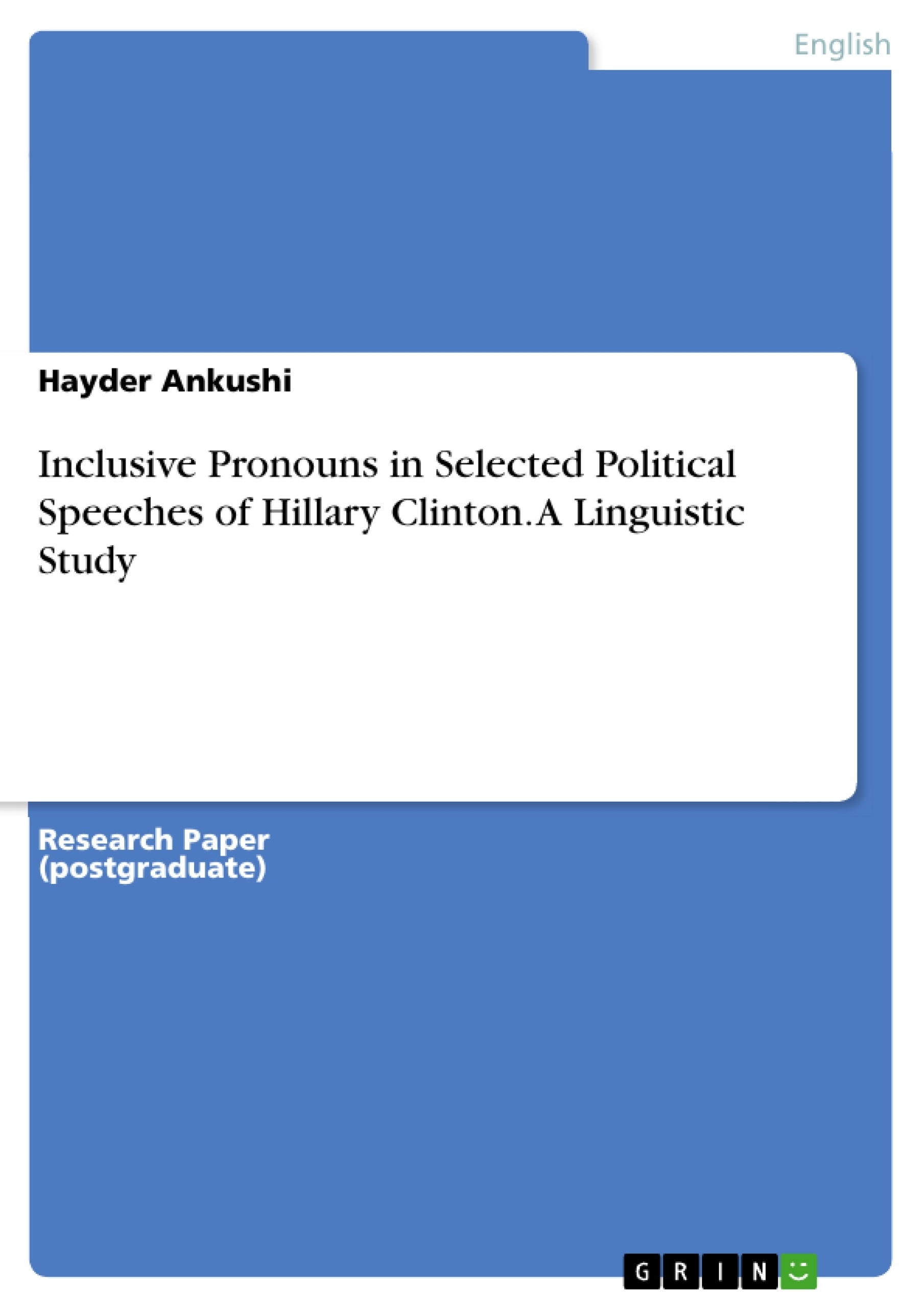Political speeches have different tools in making speeches so influential . One of these tools is using inclusive pronouns . The study concentrates on a famous political figure , Hillary Clinton , who is nominated for running a president . Clinton has a long history in politics and elections . The study analyses three speeches about three different occasions during her time in 2016 . The results of these speeches show that inclusive pronouns are highest among other personal pronouns .
Inhaltsverzeichnis (Table of Contents)
- 1. Introduction
- 1.1 Public Speaking
- 1.2 The Context of Human Communication
- 1.3 Pronouns in Political Speeches
- 2. Pronouns
- 2.1 Types of Pronouns
- 2.2 Inclusive Pronouns
- 3. Methods
- 4. Data
- 5. Analyzing Clinton's Speech
- 5.1 Clinton's Speech at Georgetown Institute
- 5.2 Clinton's Concession Speech at Presidential Election
- 5.3 Clinton's Speech in New York
Zielsetzung und Themenschwerpunkte (Objectives and Key Themes)
This study aims to analyze the use of inclusive pronouns in three selected political speeches by Hillary Clinton during her 2016 presidential campaign. The research seeks to understand the role of inclusive language in political communication and its potential impact on audience engagement and persuasion.
- The function of language in political discourse.
- The use of inclusive pronouns in political speeches.
- The analysis of Hillary Clinton's communication style.
- The impact of language choices on political messaging.
- The relationship between language and political power.
Zusammenfassung der Kapitel (Chapter Summaries)
1. Introduction: This chapter introduces the study's focus on the role of language, particularly inclusive pronouns, in political speeches. It establishes the context by discussing the multifaceted nature of politics and its reliance on effective communication. The chapter explores differing perspectives on the definition of politics, highlighting its potential for both conflict and collaboration. It also emphasizes the importance of language in shaping perceptions of authority and consensus within the political sphere. The chapter sets the stage for investigating how Hillary Clinton utilizes language to achieve political aims.
1.1 Public Speaking: This section delves into the complexities of public speaking, emphasizing the significant preparation required beyond the visible presentation. It defines public speaking within the context of political discourse, highlighting its role in persuading audiences and maintaining trust. The section underscores the importance of effective public speaking in democratic societies, where freedom of expression is paramount. The connection is made to Hillary Clinton's speeches and their role in her election campaign.
1.2 The Context of Human Communication: This section briefly introduces different communication contexts, focusing on interpersonal communication as a relevant aspect to understand how Clinton engages with her audience in her speeches. It lays the groundwork for understanding the dynamic interaction inherent in political communication.
Schlüsselwörter (Keywords)
Inclusive pronouns, political speeches, Hillary Clinton, language analysis, political communication, persuasion, public speaking, 2016 presidential election, communication context.
Hillary Clinton's Speeches: A Language Analysis - FAQ
What is the main topic of this study?
This study analyzes the use of inclusive pronouns in three selected political speeches delivered by Hillary Clinton during her 2016 presidential campaign. It investigates the role of inclusive language in political communication and its impact on audience engagement and persuasion.
What speeches are analyzed?
The study examines three specific speeches by Hillary Clinton: her speech at the Georgetown Institute, her concession speech following the presidential election, and another speech delivered in New York. The exact dates and specific contexts of these speeches are not detailed in this preview.
What are the key themes explored in the study?
Key themes include the function of language in political discourse, the use of inclusive pronouns in political speeches, Hillary Clinton's communication style, the impact of language choices on political messaging, and the relationship between language and political power.
What is the objective of this research?
The research aims to understand how inclusive language contributes to political communication, its effectiveness in engaging audiences, and its potential to persuade voters. It seeks to analyze Clinton's communication strategies and their effectiveness within the political context.
What methods are used in the study (as previewed)?
The preview does not explicitly detail the specific methodologies used, but it implies a qualitative analysis focusing on the language used within the chosen speeches. This likely includes an examination of pronoun usage to assess the degree of inclusivity in her communication.
What is included in the "Introduction" chapter?
The introduction sets the stage by discussing the multifaceted nature of politics, the role of effective communication, differing perspectives on the definition of politics, and the importance of language in shaping perceptions of authority and consensus. It specifically introduces the focus on inclusive pronouns in Hillary Clinton's speeches.
What does the chapter on "Public Speaking" cover?
This section delves into the complexities of public speaking, particularly in the political context, highlighting the importance of preparation and its role in persuading audiences and maintaining trust. It connects effective public speaking to democratic societies and its relevance to Hillary Clinton's campaign speeches.
What is covered in the chapter on "The Context of Human Communication"?
This section provides a brief overview of communication contexts, focusing on interpersonal communication to understand how Clinton engages with her audience. It lays the groundwork for understanding the dynamic interaction within political communication.
What are the keywords associated with this study?
Keywords include: Inclusive pronouns, political speeches, Hillary Clinton, language analysis, political communication, persuasion, public speaking, 2016 presidential election, and communication context.
What kind of data is analyzed?
The study analyzes the transcripts of three selected speeches by Hillary Clinton. The specific data points analyzed within these transcripts (e.g., frequency and types of pronouns) are not detailed in the preview.
- Quote paper
- Hayder Ankushi (Author), 2017, Inclusive Pronouns in Selected Political Speeches of Hillary Clinton. A Linguistic Study, Munich, GRIN Verlag, https://www.grin.com/document/367768



